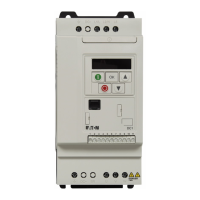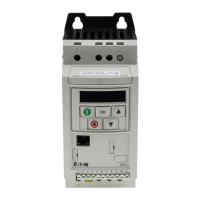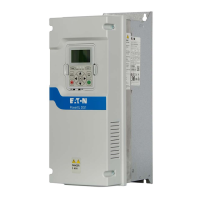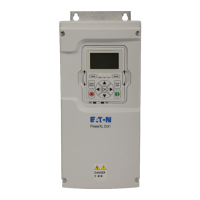5 Operation
5.5 Commissioning with control signal terminals (default settings)
DC1-S…20…, DC1-S…OE1 Variable Frequency Drives 05/21 MN040058EN www.eaton.com 115
5.5.2.2 t-Boost (P-33)
Once you have determined the correct value for V-Boost, you will need to
adjust the t-Boost (P-33) parameter. This can be done in large increments of
approximately 50 % until you are close to the required value.
The ideal duration is approx. 1 to 2 seconds longer than the duration required
in order to bring the motor to full speed.
▶ Make sure that the correct value for V-Boost (P-11), as determined with
the procedure described in → section 5.5.2.1, “V-Boost (P-11)”, is set.
▶ Select a speed reference value that is lower than the maximum value.
This will make it possible to recognize the end of t-Boost, as the motor
will then decelerate to the set speed.
▶ Start the drive. Press the OK button as many times as necessary until
the current, “A…xxx”, is displayed.
▶ Check whether the motor starts with a rising voltage.
After the motor starts, the current will increase. As soon as the motor
reaches its full speed, the current will decrease rapidly. If the time set
with t-Boost is too long, the voltage at this point will still be relatively
low and the motor will be rotating with a high current.
▶ Determine the time between the moment the motor starts and the
moment it reaches full speed.
▶ Reduce the t-Boost value and repeat the test.
▶ If the motor reaches its full speed before t-Boost elapses, keep
reducing the value of t-Boost and repeating the test.
It is not uncommon for the O-I and It.trp faults to occur during this
testing phase. If the device trips, wait at least 30 seconds before running
the test again.
▶ If the value of t-Boost is too large, the motor will continue to run with a
reduced voltage and, accordingly, a higher current for some time after
starting. If this occurs, reduce the value of t-Boost (P-33).
5.5.2.3 f-Boost (P-32)
In most cases, f-Boost (P-32) will be equal to the rated motor frequency
(P-09) and will not need to be adjusted during commissioning.
If necessary, however, the value can be changed.

